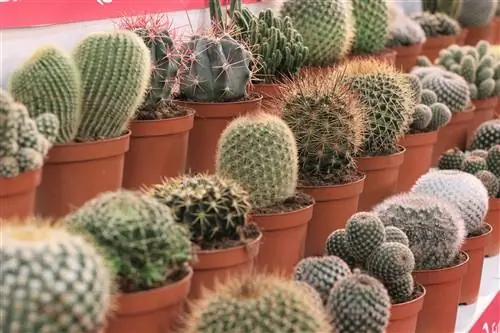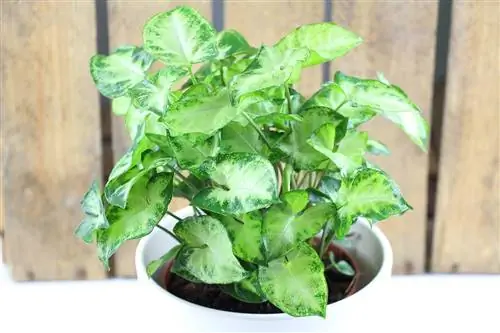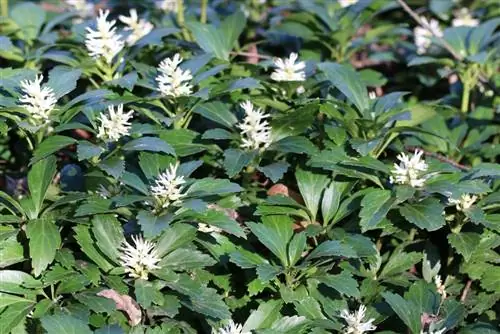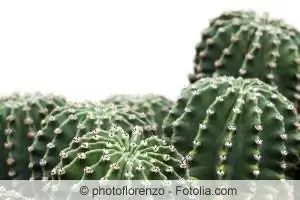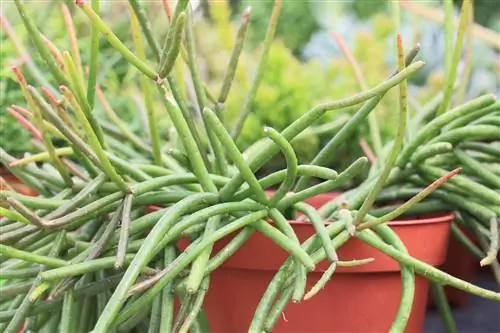- Author admin [email protected].
- Public 2023-12-17 03:39.
- Last modified 2025-06-01 06:48.
Most people associate a cactus with desert. However, there are also some species whose natural distribution is meadows and forests. These include leaf cacti such as Lepismium or Disocactus. The desert cactus family includes, for example, Cephalocereus and Cleistocactus. Most of the approximately 2,000 species come from North and South America. The exotic plants do not require much care and are therefore also suitable for beginners. However, a few small things should be taken into account.
Cactus Care
Even though cacti are quite robust, they should not be cared for carelessly. The basic requirements are sun, warmth and not too wet soil. However, unlike desert cacti, forest and meadow cacti do not like direct sunlight. But still a bright location. Too little light and too much heat make the prickly children go crazy.
Site conditions
If you want to buy a cactus, you should also offer it an optimal location. Depending on the future location, you can quickly find the right prickly plant.
Cactus as a houseplant
- no window seat: no cactus!
- North window seat: Only Christmas and Easter cacti thrive here.
- East or west window: correspond to most cactus species, well suited for Notocactus or Mammillaria.
- South window: Optimal location if shading options are available, ideal for ferocacti or opuntia.
Cactus in the open field
- rain-protected place: on the south or west side of the house offers the best possible conditions.
- unprotected place: is not a problem for many types of cactus, if the weather is wet and cold the plant should be kept dry, water drainage is important.
Soil conditions
Commercial potting soil is not suitable as a substrate because it usually contains too much nitrogen fertilizer. Below is a small summarized list:
- most cacti: a mixture of cactus soil and aquarium sand (25 percent)
- sour-loving cacti: enrich the above mixture with 20 percent rhododendron soil
- mineral-loving cacti: mixture of 20 percent cactus soil and lavalite, 15 percent clay and 45 percent aquarium sand
- Cacti with turnip-like roots: lots of sand and stone, little humus
- Cacti with fine roots: increase humus content
- Christmas and Easter cacti: loosely filled rhododendron soil
Tip:
Please do not use building sand! This contains too much lime and promotes jaundice (chlorosis) in the prickly children.
Watering and fertilizing
Like most other plants, cacti are watered during the flowering and growing season. Low-lime tap water or rainwater is suitable here. Water until the substrate no longer absorbs water. Only water again when the substrate is really dry. Avoid waterlogging.
Tip:
When the protégé is watered from the base pot, you can tell from the upper layer of soil when the root ball has absorbed enough moisture. The top soil is moist.
When fertilizing, the following applies: The slower the plant grows, the fewer nutrients it needs. Cactus fertilizer contains little nitrogen, but twice as much potassium and phosphorus. Fertilization is carried out once a month between April and September.
Wintering
In the cold season, the cactus also switches down to winter mode. In order to optimally overwinter your prickly friend, you should:
- he can't be cast
- The cactus should be kept dry, airy and cool at 8 to 12 °C
Some cacti prefer to overwinter without a plant pot. In this case, newspaper protects the root ball.
Repotting
There are various reasons to repot your little prickly friend. Be it due to lack of space or used soil. Of course, spring is the best time. After repotting, wait a few days until the plant can be watered. Repotting takes place every two to three years.
Propagate
Propagation from seeds
- First clean and dry seeds
- Place seeds in planting bowl with drainage holes and sifted cactus soil
- water from below and keep evenly moist
- place covered in a warm, bright place
- Prick out after germination
Propagation from cuttings
- Cut the cutting at a narrow point
- let it dry
- Stick vertically into gravel or sand and keep moist
- repot in cactus soil after root formation
Diseases, pests and other problems
Illnesses hardly occur among these robust fellows. If the cactus suffers from slimy tissue in places, there could be a bacterial infection. Cauliflower-like growths are a viral disease. In both cases, the affected areas should be cut off and the interfaces disinfected. Cacti are often plagued by mealybugs and spider mites. In these cases, only the use of pesticides usually helps.
Tip:
With enough fresh air, adequate supply of nutrients and proper care, pests and fungi have no chance.
Frequently asked questions
My cactus turns reddish brown in the sun. Why is that?
There are species of cacti that react with a brown color when exposed to direct and too intense sunlight. As a rule, the color disappears again if the cactus is placed in a place that is protected from the sun.
What can I do if my cactus becomes soft and looks yellowish?
The cause of these symptoms is overhydration. The plant rots. If the entire cactus is affected, there is no way to save it. In the initial stages, try to stop watering for a certain period of time and then water less.
Tips for speed readers
- undemanding robust plant
- more than 2,000 species
- Plant should be purchased according to the location
- East, west and south windows are ideal as houseplants
- outside a place protected from rain
- choose the appropriate substrate depending on the type of cactus
- Do not use building sand - it contains too much lime
- water the plant during the growing season until the soil can no longer absorb moisture
- Wait until the substrate is completely dry before watering again
- do not water in winter
- cool, airy and spots
- optimum is 8 to 12 °C
- repot every two to three years
- Propagation from seeds and cuttings possible
- common pests are mealybugs and spider mites
Care errors and consequences
The cacti are very robust plants that rarely suffer from diseases or pests. However, unnatural transformations often occur, but in most cases these are due to care errors. These include, for example: B. Cacti, which become very soft and often take on a yellow color. In this case, there has clearly been too much watering and the cactus is starting to rot. The only thing that helps here is to stop watering completely. However, in this case, improvement is only in sight if the rot is still in its early stages. In the final stage, however, the plant is hopelessly lost. The rot doesn't just have to come from too much watering, but can also be caused by frost damage. That's why cacti should never be exposed to temperatures that are too cold and they should certainly not be allowed to overwinter outside unprotected!
If a brown and corky discoloration occurs on the root neck, this is referred to as corking, which is completely normal for many types of cacti. So there is no need to worry here. If, on the other hand, the cactus has a reddish discoloration, this is often a sign of sunburn. In this case, you should immediately remove it from the area of direct sunlight. If there is only a slight sunburn, there is a good chance that the discoloration will slowly disappear again.
Typical diseases of cacti are hardly found. Basically there is only partial development of slimy and spongy areas. This occurs when the plant is infected by a bacterial infection. In addition, you can only find outgrowths that are almost similar to the well-known cauliflower. A viral disease is often the cause here. In both cases, only one remedy helps - the affected areas must be rigorously cut out or scraped out - and very generously so that no other parts of the plant can be damaged.
Some interesting cacti and succulents
- Carrion Flower
- Aloe Vera
- Bishop's hat
- Prickly Pear Cactus
- Christmas cactus
Pests on cacti
The black weevils are particularly well-known as pests for cacti. They are particularly dangerous for plants because they have become resistant to almost every chemical killer. Not only do they gnaw off the leaves, the larvae often gnaw on the roots of the cacti and settle in the shoots. Since an infestation with these black weevils almost always leads to the death of the cactus, it is important to examine the soil carefully for traces of these pests when repotting. But spider mites are also a big enemy of cacti. They tend to occur when the air in the room is too dry, especially if the cacti are kept in a greenhouse. You can often get rid of these animals by regulating the temperature to around 21° C and significantly increasing the humidity. You can also introduce the natural enemy of spider mites, the mite Phytoseilus persimilis, into the greenhouse. In this way, the spider mites are destroyed in a natural way and the cacti are not additionally weakened with chemical weapons.
If small, shell-shaped bumps appear on the cactus, this is often an indication of scale insect infestation. Here it is necessary to scrape off the elevations. If the infestation is small, this measure should be sufficient, but if the infestation is more severe, systemic insecticides must be used.
In general, however, it is assumed that most pests are introduced by other plants. It is therefore important to repot new cacti immediately after purchasing them and to inspect them for pest or disease infestation. You should also place the newly purchased plants separately for a few weeks and observe them. Because some damage only becomes apparent over time. This still prevents infection of other plants.

